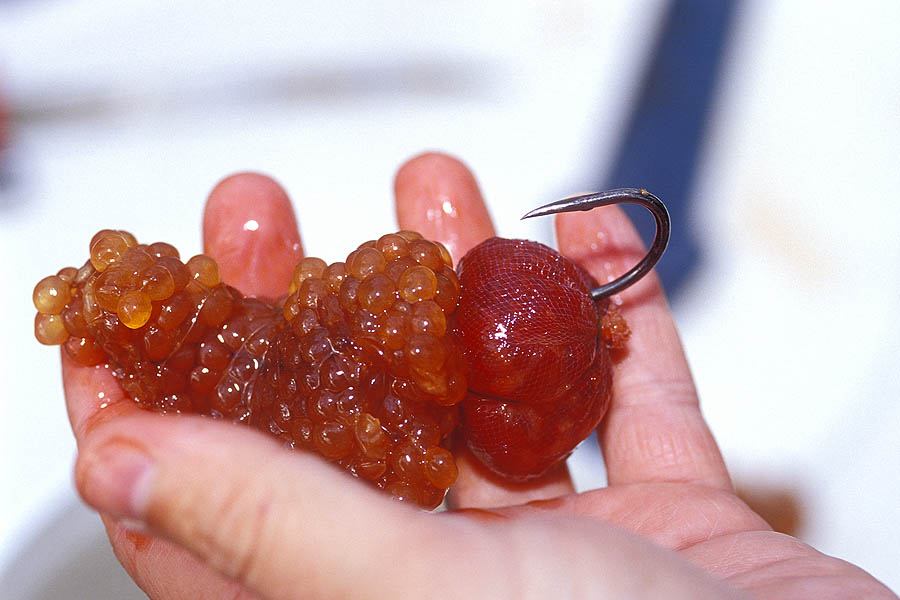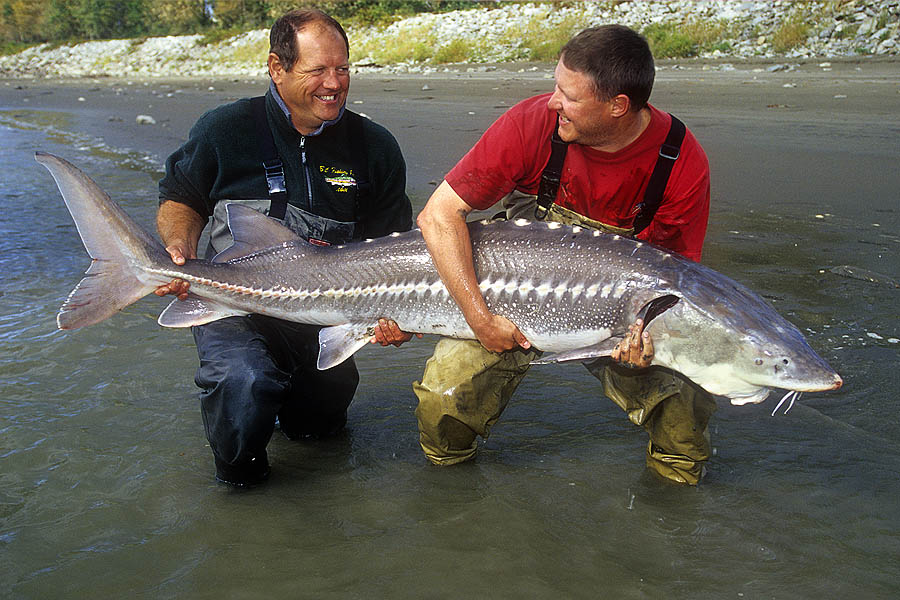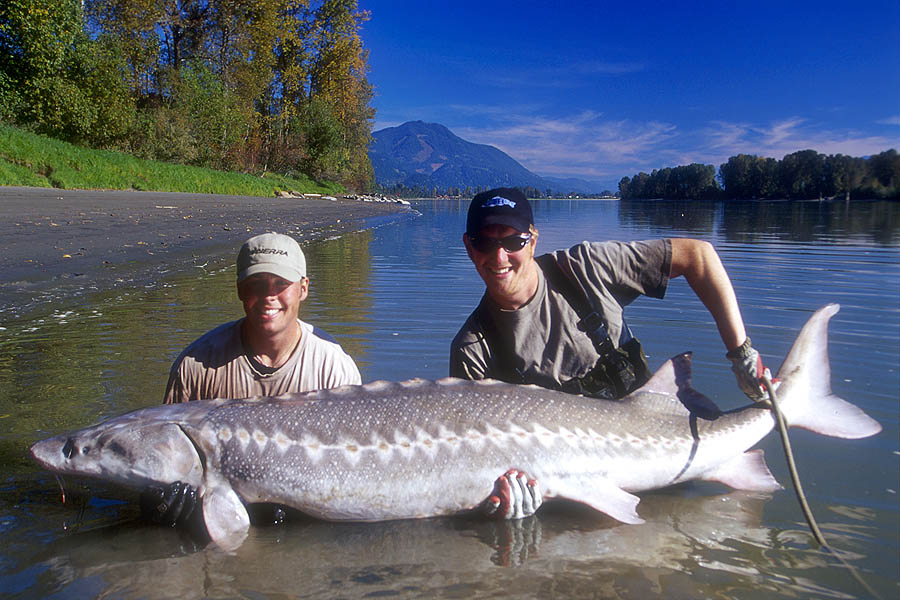 (2001-2004) It probably doesn't come as a great surprise to most anglers that fishing in Canada is phenomenal. Well, I discovered it myself this October, when I went with six of my friends to Fraser River in British Columbia. Our primary goal was the great white sturgeon, and then possibly some salmon and trout.
(2001-2004) It probably doesn't come as a great surprise to most anglers that fishing in Canada is phenomenal. Well, I discovered it myself this October, when I went with six of my friends to Fraser River in British Columbia. Our primary goal was the great white sturgeon, and then possibly some salmon and trout.
On the second fishing day my friends had all caught their biggest fish, ever…
August 2001
The trip was planned well in advance – a year before to be exact. I had just spent weeks with me wife and son, driving around in the Canadian Rockies, experiencing the absolutely stunning nature and wildlife, when the urge to fish became too great. Episodes with black bear near our tent, bald eagles, moose and bighorn sheep was not enough – I had to fish – if only one day.
I had previously emailed with Ken Kristian from Mission, BC, who generously helped me get in contact with the guide John Sheriff, so I called John a couple of days before going back to Denmark. The weather was dreadful and I honestly didn't think John would take me fishing, but luckily I was wrong. The weather, however, didn't change, so fishing was a bit slow, but we managed to land a few small'ish sturgeon to about 15 lbs, and then lady luck showed up and I caught a 100 pound'er.
It was a spectacular fight, and the fish looked fantastic, even in the rain, so what can I say – I just had to go back and try again…
October 2002
In October I was back again, and this time with some of my capable fishing friends, who were equally eager to catch the brilliantly fighting white sturgeon.
We arrived to the most divine weather – a welcome change to last year – and we even had misty mornings on the river, which made everything look and feel even more adventurous. With my photographic drive, I felt we just couldn't get any luckier. Well, we could, and we did…
We fished 6 days, and we had all the fun & fight we could ask for. All seven of us caught at least one 100 pound'er + many between 50 and 100 lbs. The biggest fish we got, weighed 350 lbs and measured just under 8 feet – very fat for a white sturgeon. Other 7 footers were caught in the range of 150 to 200 lbs.
Thinking back on the trip I get flashes of blue skies with launching leviathans, even the ones that only got nicked by the hook, beautiful colours and patters in the skin of the sturgeon's heads, ridiculously long vacuum cleaner mouths, screaming bald eagles above us along with ultra light floatplanes, endless train columns, happy and strained anglers faces at daytime, and happy and tired anglers faces at night.
 Baits & techniques
Baits & techniques
On these two trips I have seen quite a variety of baits. The sturgeon eats just about anything, but for periods of time they gorge themselves in specific food, which is naturally presented to them. In the spring, for example, they even migrate downstream to get a seat at the table, when the eulachon is present. The eulachon is a smelt type fish, which is very fat, and the sturgeon will eat nothing else, while these fish are in the river.
We primarily used salmon roe, and that worked very well. As there were several salmon species in the river at the time, we had different types to play around with, but all in all I think the key motivator for the sturgeon was the freshness of the roe.
Bait presentation using roe is actually easier than one should think. The fresh roe contains some ligaments, which hold the roe together, so you can actually tie the roe directly onto the hook and the line with thin elastic thread. This method was no doubt the most "instant" bait presentation, but it also produced a seriously lower average in fish weight. The best catching bait and presentation was roe in bags of either nylons or wedding veil – this way the juices of the roe could seep out, and the roe will stay fairly intact even after several takes.
The other baits that are good in specific situations are ditch eels and lamprey, and salmon belly meat.
All baits were fished using running ledger with leads of 18-24 oz. The current is depending on the tide, even so far inland, and in the main channel you can't fish properly when the current is at it's fastest. It's also in the main channel that the bigger fish stay for longer periods of time. The individual (big) fish seem to stay in a specific areas or territories.
Strike, fight & landing
I fished for beluga sturgeon in the Ural Delta, Kazakhstan, and the one big difference from fishing beluga sturgeon, as opposed to white sturgeon, is the bite. Beluga sturgeon take the bait with no reservations, but the white sturgeon can be very, very finicky to the point of utter frustration to the angler. You can feel through the braided line how the white sturgeon fiddles with the bait, and knowing that this could be a fish of anything between 5 and 500 lbs, drives your concentration to the limits of madness.
When there's a bite, you slowly take the rod out of the holder, and try and keep the rod tip steady, so there's no change in the position of the bait that might scare the fish away. At this time John Sheriff usually tells us to get ready, and I told him that if I try and get any more ready, I'd shit myself.
You then wait for a steady pull from the fish, and follow the motion of the pull, and make a couple of healthy strikes.
 Now's when the fun really starts, even though sometimes they don't realize for little while, that they have hooked, but when they do - Oh Man!
Now's when the fun really starts, even though sometimes they don't realize for little while, that they have hooked, but when they do - Oh Man!
You do well, just hanging on the bloody rod, and then there's all the jumping and pumping, huffing and puffing (and I'm still talking fishing). The sturgeon can move very fast, and all of sudden you have hundreds of yards of line out, and getting a big fish back to the boat can very well take a couple of hours. The biggest sturgeon we got on the trip (350 lbs) took a very fit young guy 2½ hours to land.
When you have been fighting for a long time, a good sign that the sturgeon is about to give in is, when it suddenly releases air – probably a last effort to get back to the safety of the bottom by becoming a little heavier.
Almost all sturgeon to around 100 lbs were landed in the boats without problems. A safe way to get a big fish into the boat is by letting a rope around its body, just behind the pectoral fins, where its point of balance is located, and lifting it in the rope and by the tail.
The biggest sturgeon was another matter, both handling-wise, -safety-wise & -photo-wise. The biggest problem with beach landing the fish is, of course, that it can recover some of its power during the boat ride to shore, and start fighting again – with the risk of losing it then.
Gear & tackle
The rods that we used are Lamaglas custom built one piece 8 1/2 footers with Penn 330 GT reels with 400 yards of 80 lbs braided line. The hooks we used were size 6/0 and 7/0 Gamakatsu, with 100 lbs mono leaders.
